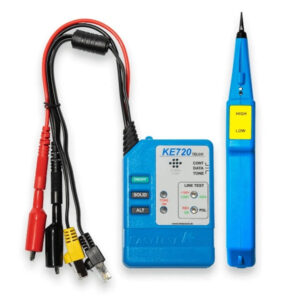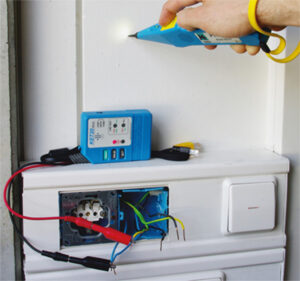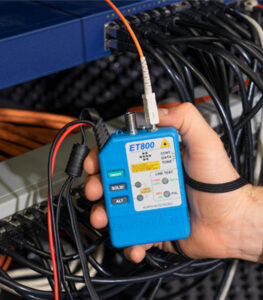
In an unknown building or at an unknown installation, it is very helpful to have a cable locator. With simple means, you can determine cable paths with this.
What is the quickest way to find the wire pair? What cable tracing options are feasible? These are just a few of the questions that are answered with a cable finder.
1 What tasks should a cable finder perform?
Cable finders, also known as cable tracers or line tracers, are little helpers that make the daily work of installers and tradesmen easier. By quickly finding cable and wire routes, they mean significant time savings.
In addition, you can use a cable finder to assign fuses and wire pairs. Cable faults, such as interruptions and wire interchanges, can also be detected.
All that is needed is a known side of the cable to which you can connect the cable.
1.1 What types of cable finders are there?

Fig. 1: KE701 from Kurth Electronic, consisting of a search signal transmitter (left) and a receiver (right)
Locating devices are devices with which you can locate, for example, metals or various cables in walls. A distinction must be made between a locating device and a cable tracer.
Locating devices are wall scanners with which metal pipes, power lines and sometimes even wooden beams can be detected. To do this, wall scanners generate an electrical field that is used to analyse the wall. Changes in the reflection indicate metallic objects. Most of the time, however, it is not easy to ensure an exact localisation of cables with these devices, because these locating devices also react to all other metals, such as nails or similar objects, in the wall. Thus, it is often not possible to obtain a clear result.
A classic cable tracer, on the other hand, consists of a transmitter and a receiver, also called toner and probe. The transmitter sends a search signal onto the cable, which you then can locate with the receiver.
1.2 How do these line tracers work exactly?
A line tracer consists of a transmitter and a receiver. The transmitter is used to inject a modulated electrical signal onto the cable to be searched. The receiver can then track this electromagnetic signal by converting it into a tone that can be heard by the user. The volume of this sound additionally provides information about the distance to the line. With a cable tracer, it is possible to find cables, such as power lines or telephone lines, or to identify the correct wire from a bundle.
1.3 Can a cable finder also be operated in the active network?
This question cannot be answered in a general way. Line tracers are available in different versions. In order to be able to work in active networks, it is important that the transmitter has overvoltage protection, as devices that do not have this protection would be damaged when connected to live lines. There are special devices for line tracing in active 230 V networks, such as our KE2093. You can use it on active voltages up to 300 V. This makes line tracing possible even on live wires. Such a type of line tracer is often used within critical infrastructures such as hospitals, where you cannot simply switch off a fuse in case of doubt.
Excellent for active telecommunication networks are our specialised cable finders for professionals, such as the KE701. These have 500 V overvoltage protection, which protects them from damage in the event of accidental contact with live lines. They also have additional special functions such as a continuity check or a port finder function and are used by various network operators, technicians and professionals worldwide.

Fig. 2: Port Finder/Data Link option of the KE801
2 Where can a cable finder be used?
You can use cable finders in a wide variety of ways, e.g. in building wiring, domestic installations or even in larger factory buildings. Cables can be found in masonry or in sheetrock. With a cable finder you can also find junction boxes that have been accidentally plastered over.
Cable tracers are also used by network operators in telecommunications networks to find the right cables between exchanges, cable junctions and house connections.
2.1 Which lines can be traced with a cable finder?
In principle, you can detect all types of cables with a cable finder, including telephone lines, network lines, power lines or coaxial cables. You must first connect the signal transmitter to the corresponding cable. Then a signal is modulated onto the cable in order to track it with the receiver.
2.2 How far does the signal of a cable tracer reach on the line?
Modern cable tracers such as our devices “KE301-KE801” can trace a signal up to 15 km on unloaded telephone lines. However, the signal range depends on various factors. Influencing factors are the mechanical properties of the line, e.g. the cable cross-section or kinks. The shield of a line partially or even completely prevents the signal search. Here, the shield only fulfils its purpose – namely to shield any electrical signals from the outside. Thus, with shielded cables, it makes sense in such a case to apply the modulated signal to the shield and track the cable in this way.

Fig. 3: Cable search in the wall with our KE701
2.3 How deep can the cable be in the wall?
How deep the cable can lie in the wall depends on the type of wall. In masonry, search depths of up to 30 centimetres are possible. This can be significantly reduced in damp walls or concrete walls with reinforcement. Plaster grids also weaken the signal because they act like a screen. The different wall materials as well as their thickness attenuate the signal and can influence the search depth.
2.4 Can data ports in a network also be identified?
New models, like our KE801, also have various additional functions such as continuity check or port finder/data link function. With this function, it is possible to easily and quickly find sockets in active networks that are not labelled and thus cannot be assigned to a switch. The data link function shows on the switch where the outlet is patched by a rhythmic, unique flashing of the link LED.

Fig. 4: KE801 with fibre optics laser light source
2.5 Can line tracers also find fibre optic cables?
Optical fibres cannot be tracked with a classic line tracer because they transmit their signals in the form of light instead of electrical pulses.
However, it is possible to check optical fibres for continuity or to identify specific fibres from a bundle – similar to the wire pair identification of copper cables. For this purpose, our KE801 has a unique combination of a fibre optic red light source which you can to optical fibres and whose laser light can be detected at the other end.
3 What are the advantages or disadvantages of a cable finder?
As described so far, you can trace and identify a large number of lines quickly and easily with the help of a cable finder. Though, depending on the area of application, difficulties can arise in line tracing. Therefore, it makes sense to have specialised cable tracers that simplify the daily work.
3.1 Why does Kurth Electronic use carbon fibre test probes on the receiver?
Carbon fibre test probes are non-conductive. This has the advantage that e.g. in solderless, screwless and stripping-free distributors no short circuits are caused by the test probe when you move it close over the wire pairs to be identified without affecting the search accuracy.
3.2 Is signal search also possible under less non-optimal conditions?
Another advantage of our receiver is the signal LED for visual indication of the search signal. The integrated torch function is also very helpful for finding cables or wires in a dark environment, such as in a distribution cabinet. In addition, you can connect a headphone – this makes search signals more audible in very noisy environments.

Fig. 5: Probe410 with carbon fibre tip, signal LED and torch function
3.3 Does a cable finder interfere with the DSL or Ethernet signal?
The signal generator modulates the signal onto the line. Interference with existing signals, such as DSL, depends on the modulated signal. The amplitude and frequency of the modulated signal of the generator should be designed in such a way that an influence on the telecommunication signal is excluded. You can safely use line tracers of our “KE301-KE801” series on active DSL and Ethernet lines, as their search signal is outside the spectrum used.
Summary
Cable finders enable the detection of cables such as telecommunications lines, electrical lines, coaxial lines or network lines in a wide variety of installation environments. The search depth is up to 30 centimetres, depending on the wall material and wall thickness. Modern cable tracers do not interfere with the communication signal, such as xDSL, or can even be used on live lines. This makes them a helpful companion for installers from a wide range of disciplines.


















